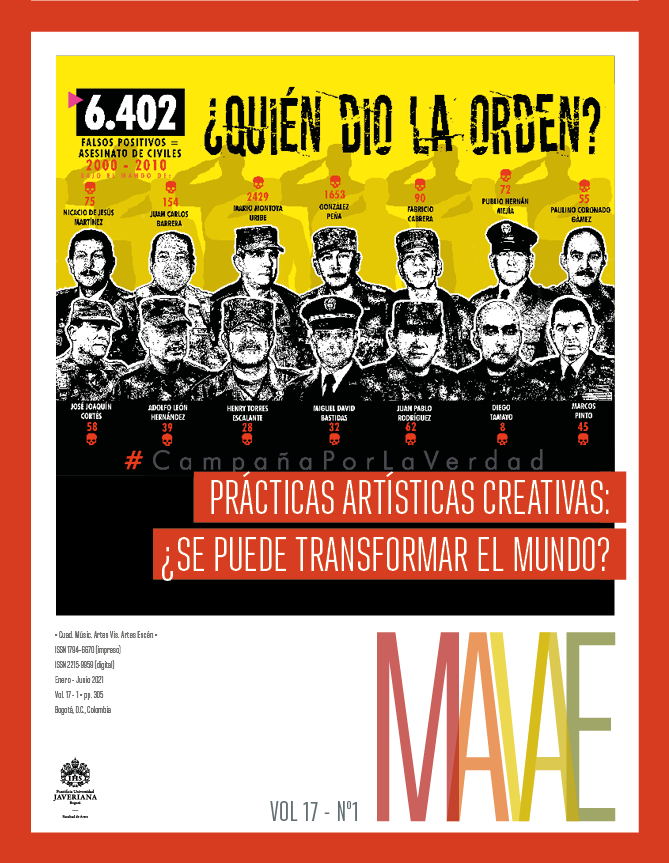Resumen
Se reflexiona sobre el proceso de construcción del jardín de la resistencia en la Estación de Metro Baquedano, espacio urbano transformado en epicentro de las movilizaciones sociales ocurridas desde el 18 de octubre 2019 en Santiago de Chile. A partir del trabajo de observación etnográfica, se describe el proceso de organización social que conduce a la elaboración de este jardín y se analizan las dimensiones que este espacio de naturaleza ofrece a la construcción de un tercer paisaje en medio de la ciudad, esto es, un paisaje donde las plantas nativas, medicinales y espontáneas crecen en medio de los escombros (metro), y que opera como metáfora de la explosión de ira y la violencia desplegada en los meses que dura la protesta. Entre escombros, grafitis, acciones de arte y la toxicidad de la revuelta, la vegetación crece para conmemorar a los caídos y recordarnos la cualidad resiliente de la vida y que, como todo tercer paisaje, este es un espacio que no expresa ni el poder ni la sumisión a este, por lo que permite construir una comunidad emocional desde la rebeldía y la belleza. Se concluye que, como fragmento irresoluto, el jardín abre la posibilidad de que la naturaleza tome protagonismo y proponga un nuevo orden, una evolución conjunta, recíproca y horizontal de los seres que lo habitan en medio del desorden y borramiento en el centro de la ciudad.
Adams David, Michael Hardman y Peter Larkham. 2014. “Exploring Guerrilla Gardening: Gauging Public Views on The Grassroots Activity”. Local Environment: The International Journal of Justice and Sustainability 20, n.º 10: 1-16. https://doi.org/10.1080/13549839.2014.980227.
Araujo, Kathya, ed. 2019. Hilos tensados: Para leer el octubre chileno. Santiago de Chile: Universidad de Santiago de Chile. https://www.researchgate.net/profile/Kathya-Araujo/publication/340315513_Hilos_Tensados_Para_leer_el_octubre_chileno/links/5e83c0aaa6fdcca789e58495/Hilos-Tensados-Para-leer-el-octubre-chileno.pdf.
Butler, Judith. 2010. Cuerpos que importan: Sobre los límites materiales y discursivos del “sexo”. Buenos Aires: Paidós.
Butler, Judith y Athena Athanasious. 2017. Desposesión: Lo performativo en lo político. Buenos Aires: Eterna Cadencia.
Campos, Ricardo. 2015. “Youth, Graffiti, and the Aestheticization of Transgression”. Social Analysis 59, n.º 3, 17-40. https://doi.org/10.3167/sa.2015.590302.
Candau, Joel y Paul Hameau. 2004. “Cicatrices murals: Les graffiti de prison”. Le Monde alpin et rhodanien: Revue régionale d’ethnologie 32, n.º 1-2: 7-11.
Cepal (Comisión Económica para América Latina y el Caribe). 2017. “Estudio económico de América Latina y el Caribe 2017: La dinámica del ciclo económico actual y los desafíos de política para dinamizar la inversión y el crecimiento”. https://www.cepal.org/es/publicaciones/42001-estudio-economico-america-latina-caribe-2017-la-dinamica-ciclo-economico-actual
Clément, Gilles. 2014. Manifiesto del tercer paisaje. Barcelona: Gustavo Gili.
Clément, Gilles. 2019. Una breve historia del jardín. Barcelona: Gustavo Gili.
Criado-Boado, Felipe y Daniel Barreiro. 2013. “El patrimonio era otra cosa”. Revista Estudios Atacameños: Arqueología y Antropología Surandinas,n.º 45: 5-18. http://dx.doi.org/10.4067/S0718-10432013000100002.
De la Cadena, Marisol, ed. 2010. Indigeneidades contemporáneas: Cultura, política y globalización. Lima: Institut français d’études andines.
Didi-Huberman, George. 1997. Lo que vemos, lo que nos mira. Buenos Aires: Manantial.
Didi-Huberman, George. 2017. Sublevaciones. Buenos Aires: Universidad Nacional de Tres de Febrero.
Endres, Danielle y Samantha Senda-Cook. 2011. “Location Matters: The Rhetoric of Place in Protest”. Quarterly Journal of Speech 97, n.º 3: 257-282. https://doi.org/10.1080/00335630.2011.585167.
Errázuriz, Luis y Gonzalo Leiva. 2012. El golpe estético: Dictadura militar en Chile, 1973-1989. Santiago de Chile: Ocho Libros.
Fraser, Nancy. 2009. Scales of Justice: Reimagining Political Space in a Globalizing World. Nueva York: Columbia University Press.
Frederick, Ursula. 2009. “Revolution is the new black: Grafiti/Art andMark-making Practices”. Archaeologies: Journal of the WorldArchaeological Congress 5, n.º 2: 210-237. https://doi.org/10.1007/s11759-009-9107-y.
González, Raúl y Francisca Márquez. 2019. “Chile: De los subterráneos al protagonismo, ¿ocaso del modelo neoliberal?”. https://www.iade.org.ar/noticias/chile-de-los-subterraneos-al-protagonismoocaso-del-modelo-neoliberal.
González, José de Vicente. 2002. Boticas monásticas, cartujanas y conventuales en España. Santa Comba Coruña: Resctres.
Hirschman, Albert. 1980. El avance en colectividad: Experimentos populares en la América Latina. México: Fondo de Cultura Económica.
INDH (Instituto Nacional de Derechos Humanos). 2020. “Información constatada por el INDH al 31-01-2020”. https://www.indh.cl/
Jimeno, Myriam. 2007. “Lenguaje, subjetividad y experiencias de violencia”. Antípoda: Revista de Antropología y Arqueología, n.º5: 169-190. https://doi.org/10.7440/antipoda5.2007.08.
Luengo L. María Tránsito. 2008. “Flavonoides”. Offarm: Farmacia y Sociedad 21, n.º 4: 108-113.
Márquez, Francisca, Marcelo Colimil, Daniela Jara, Víctor Landeros y Constanza Martínez. 2020. “Cuando las paredes hablan: Rastros del estallido social en el metro Baquedano, Santiago de Chile”. Praxis Arqueológica 1, n.º 1: 98-118. https://doi.org/10.11565/pa.v1i1.10.
Morán Alonso, Nerea y Agustín Hernández Aja. 2011. “Historia de los huertos urbanos: De los huertos para pobres a los programas de agricultura urbana ecológica”. En Actas del I Congreso Estatal de Agricultura Ecológica Urbana y Periurbana. Elche. https://oa.upm.es/12201/.
Muñoz Orlando, Marco Montes y Tatiana Wilkomirsky. 2004. Plantas medicinales de uso en Chile: Química y farmacología. 2.ª ed.Santiago de Chile: Editorial Universitaria.
MHT (Medicamentos Herbarios Tradicionales). 2009. “103 especies vegetales”. https://www.minsal.cl/wp-content/uploads/2018/02/Libro-MHT-2010.pdf
Reguillo, Rossana. 2017. Paisajes insurrectos: Jóvenes, redes y revueltas en el otoño civilizatorio. México: NED.
Riedemann, Paulina y Gustavo Aldunate. 2014. Flora nativa de valor ornamental. Vol. 1: Identificación y propagación. Chile zona norte. Santiago de Chile: Jardín Botánico Chagual.
Stoetze, Bettina. 2018. Ruderal Ecologies: Rethinking Nature, Migration, and the Urban Landscape in Berlin. Cultural Anthropology 33, n.º2: 295-323. https://doi.org/10.14506/ca33.2.09.
Skewes, Juan Carlos y Rodolfo Quiroz. 2020. “Lecciones del Negro Matapacos”. La Raza Cómica. https://razacomica.cl/sitio/civilizacion-y-barbarie/.
Taylor, Diana. 2015. El archivo y el repertorio: La memoria cultural performática en las Américas. Santiago de Chile: Universidad Alberto Hurtado.
Thoreau, Henry. 1970. Desobediencia civil. Santiago de Chile: Editorial Universitaria.
Turner, Victor 1980. Selva de los símbolos. Madrid: Siglo XXI.
Universidad Alberto Hurtado. 2020. “Ruinas urbanas”. https://ruinasurbanas.cl/2020/04/29/ruinas-urbanas-jardin-de-la-resistencia/

Esta obra está bajo una licencia internacional Creative Commons Atribución 4.0.
Derechos de autor 2021 Francisca Márquez , Margarita Reyes


